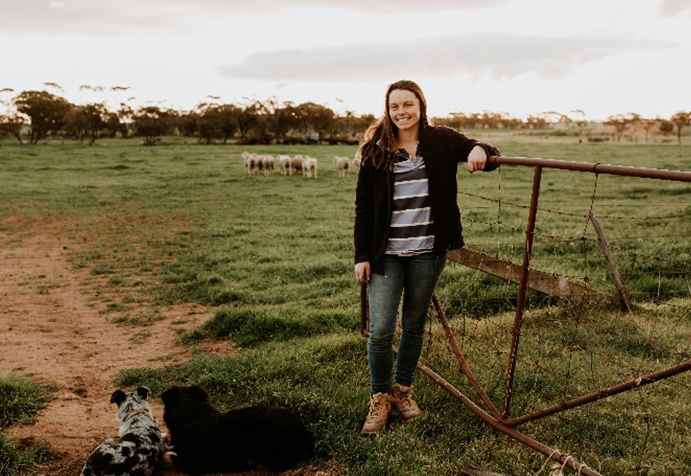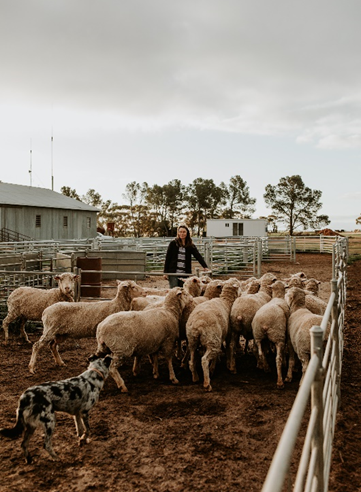The use of eID technology for efficient farm management
20 August 2024
 Sammy Mitchell on her farm at Willangie, Victoria
Sammy Mitchell on her farm at Willangie, Victoria
Producer case study: Sammy Mitchell
Mitchell’s Farm at Willangie, Victoria
Sammy Mitchell has recently taken over the management of her family’s 2,900ha mixed farming operation in Willangie, Victoria. The farm comprises cropping, hay production and livestock, including a flock of 550 Merino ewes. Until recently, Sammy’s father assisted with seeding and harvest, but the day-to-day operations fell on Sammy’s shoulders. Recognising the labour intensive nature of the work, especially in the sheep yards, Sammy invested in new infrastructure and technology to improve efficiency and management.
Technological investments
To streamline operations, Sammy invested in ClipEx yards and a ClipEx sheep handler equipped with scales, a panel reader, and auto draft capabilities. Additionally, she installed a Zetify tower for Cloud storage connectivity, enabling efficient data management. This setup is designed to enhance labour efficiency, improve animal management and facilitate better decision-making through data collection.
Livestock and management practices
Sammy currently maintains 550 Merino ewes. All ewes are mated with White Suffolk rams. Sammy's management practices are aimed at improving productivity and efficiency. For example, the farm has a small feedlot constructed using a drought grant, and this was used for the first time to finish farm-bred lambs after adverse weather conditions delayed pasture establishment.
Implementation of eID technology
Sammy has been familiarising herself with the new technology. She has successfully used the sheep handler for ear tagging, managing health tasks and clipping dags. The auto draft feature has not yet been fully utilised, but Sammy plans to use eID technology to manage the drafting of ewes and lambs based on production data, aiming to reduce time and labour in the yards and improve the accuracy and efficiency of her management decisions.
Current applications
Purchased ewe age: eID has been used to record the age of purchased ewes to plan for the number of cast-for-age ewes and their replacements.
Pregnancy scanning: Sammy uses eID to record the pregnancy status of ewes, with her scanner drafting ewes into pregnancy status groups. The ewes are then run back past the eID panel reader in their mobs, which records their pregnancy status into the Tru-Test XR5000 screen. Mobs are boxed up and managed together until late pregnancy, then auto-drafted into their pregnancy status, with twins allocated to better feed paddocks or to be fed in containment.
Lamb growth: Body weights are recorded for lambs to be sold over-the-hooks, tailoring feeding for lighter lambs kept back to finish.
Lamb survival until weaning: Record whether ewes kept their lambs, helping to assess maternal performance over time.
Lamb growth monitoring: Use eID to monitor feedlot lamb growth rates, improving the management of finishing lambs.
Sammy would like to be able to collate production data to show which ewes are more profitable over time.
Challenges and solutions

Sammy in her new yards
Sammy faced several challenges, such as equipment malfunctions during critical times and the need to manually input data, which has been time-consuming. Having enough labour resources on-farm to implement the use of eID has also been challenging. However, she has been proactive in seeking solutions, such as utilising YouTube tutorials and product guides to enhance her understanding and use of the equipment, manually entering data when needed, and ensuring data collection continued when the air compressor failed.
Future plans
Now that her partner Lachy has joined her with farm operations, Sammy is hopeful they’ll be able to utilise eID further. Some applications include:
Selective breeding: Ewes that repeatedly produce multiples would be selected to increase lambing percentage. Fleece weights could be included when profitable.
Successes and lessons learnt
Sammy emphasises the importance of collecting data to remember the production history of each ewe and make informed management decisions.
Gradual improvements in infrastructure and growing experience are showing that with the right tools and knowledge, labour and time in the yards and office can be more effective, and overall flock management can be improved.
Sammy suggests that when starting out using eID, producers start small; start with one thing like a handheld reader and, as much as possible, begin learning the skills and have hands on-farm to be able to take the measurements.
Sammy’s proactive approach to incorporating eID technology and modern infrastructure is improving the efficiency and effectiveness of her farm management.
By leveraging data-driven insights, Sammy is well-positioned to enhance productivity, make informed decisions, and continue advancing her family’s farming legacy.
Sammy is participating in the five-year Producer Demonstration Site(PDS) project funded by Meat & Livestock Australia, Southern Farming Systems (SFS) and Birchip Cropping Group (BCG). The PDS focuses on Victorian sheep producers utilizing eID technology to make better informed management decisions.
For further information:
Ali Frischke, Birchip Cropping Group T (03) 5492 2787 M 0429 922 787 E alison@bcg.org.au


